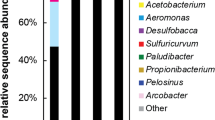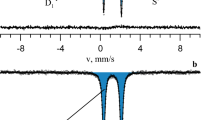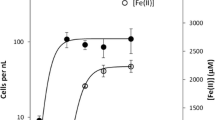Abstract
The origin of sedimentary dolomite has become a long-standing problem in the Earth Sciences. Some carbonate minerals like ankerite have the same crystal structure as dolomite, hence their genesis may provide clues to help solving the dolomite problem. The purpose of this study was to probe whether microbial activity can be involved in the formation of ankerite. Bio-carbonation experiments associated with microbial iron reduction were performed in batch systems with various concentrations of Ca2+(0–20 mmol/L), with a marine iron-reducing bacterium Shewanella piezotolerans WP3 as the reaction mediator, and with lactate and ferrihydrite as the respective electron donor and acceptor. Our biomineralization data showed that Ca-amendments expedited microbially-mediated ferrihydrite reduction by enhancing the adhesion between WP3 cells and ferrihydrite particles. After bioreduction, siderite occurred as the principal secondary mineral in the Ca-free systems. Instead, Ca-Fe carbonates were formed when Ca2+ ions were present. The CaCO3 content of microbially-induced Ca-Fe carbonates was positively correlated with the initial Ca2+ concentration. The Ca-Fe carbonate phase produced in the 20 mmol/L Ca-amended biosystems had a chemical formula of Ca0.8Fe1.2(CO3)2, which is close to the theoretical composition of ankerite. This ankerite-like phase was nanometric in size and spherical, Ca-Fe disordered, and structurally defective. Our simulated diagenesis experiments further demonstrated that the resulting ankerite-like phase could be converted into ordered ankerite under hydrothermal conditions. We introduced the term “proto-ankerite” to define the Ca-Fe phases that possess near-ankerite stoichiometry but disordered cation arrangement. On the basis of the present study, we proposed herein that microbial activity is an important contributor to the genesis of sedimentary ankerite by providing the metastable Ca-Fe carbonate precursors.
Similar content being viewed by others
References
Amstaetter K, Borch T, Kappler A. 2012. Influence of humic acid imposed changes of ferrihydrite aggregation on microbial Fe(III) reduction. Geochim Cosmochim Acta, 85: 326–341
Bonneville S, Behrends T, Van Cappellen P. 2009. Solubility and dissimilatory reduction kinetics of iron(III) oxyhydroxides: A linear free energy relationship. Geochim Cosmochim Acta, 73: 5273–5282
Bontognali T R R, Vasconcelos C, Warthmann R J, Lundberg R, McKenzie J A. 2012. Dolomite-mediating bacterium isolated from the sabkha of Abu Dhabi (UAE). Terra Nova, 24: 248–254
Bose S, Hochella Jr. M F, Gorby Y A, Kennedy D W, McCready D E, Madden A S, Lower B H. 2009. Bioreduction of hematite nanoparticles by the dissimilatory iron reducing bacterium Shewanella oneidensis MR-1. Geochim Cosmochim Acta, 73: 962–976
Chang B, Li C, Liu D, Foster I, Tripati A, Lloyd M K, Maradiaga I, Luo G, An Z, She Z, Xie S, Tong J, Huang J, Algeo T J, Lyons T W, Immenhauser A. 2020. Massive formation of early diagenetic dolomite in the Ediacaran ocean: Constraints on the “dolomite problem”. Proc Natl Acad Sci USA, 117: 14005–14014
de Vasquez M G V, Rudd B A W, Baer M D, Beasley E E, Allen H C. 2021. Role of hydration in magnesium versus calcium ion pairing with carboxylate: Solution and the aqueous interface. J Phys Chem B, 125: 11308–11319
Eusterhues K, Rennert T, Knicker H, Kögel-Knabner I, Totsche K U, Schwertmann U. 2011. Fractionation of organic matter due to reaction with ferrihydrite: Coprecipitation versus adsorption. Environ. Environ Sci Technol, 45: 527–533
Fredrickson J K, Zachara J M, Kennedy D W, Dong H, Onstott T C, Hinman N W, Li S. 1998. Biogenic iron mineralization accompanying the dissimilatory reduction of hydrous ferric oxide by a groundwater bacterium. Geochim Cosmochim Acta, 62: 3239–3257
Graf D L, Goldsmith J R. 1956. Some hydrothermal syntheses of dolomite and protodolomite. J Geol, 64: 173–186
Gregg J M, Bish D L, Kaczmarek S E, Machel H G. 2015. Mineralogy, nucleation and growth of dolomite in the laboratory and sedimentary environment: A review. Sedimentology, 62: 1749–1769
Guo C, Chen D Z, Dong S F, Qian Y X, Liu C G. 2017. Early dolomitisation of the Lower-Middle Ordovician cyclic carbonates in northern Tarim Basin, NW China. Sci China Earth Sci, 60: 1283–1298
Han Z, Qi P, Zhao Y, Guo N, Yan H, Tucker M E, Li D, Wang J, Zhao H. 2022. High Mg/Ca molar ratios promote protodolomite precipitation induced by the extreme halophilic bacterium Vibrio harveyi QPL2. Front Microbiol, 13: 821968
Hendry J P, Wilkinson M, Fallick A E, Haszeldine R S. 2000. Ankerite cementation in deeply buried Jurassic sandstone reservoirs of the central North Sea. J Sediment Res, 70: 227–239
Higgins J A, Blättler C L, Lundstrom E A, Santiago-Ramos D P, Akhtar A A, Crüger Ahm A S, Bialik O, Holmden C, Bradbury H, Murray S T, Swart P K. 2018. Mineralogy, early marine diagenesis, and the chemistry of shallow-water carbonate sediments. Geochim Cosmochim Acta, 220: 512–534
Hochella Jr. M F, Lower S K, Maurice P A, Penn R L, Sahai N, Sparks D L, Twining B S. 2008. Nanominerals, mineral nanoparticles, and Earth systems. Science, 319: 1631–1635
Huang Y R, Yao Q Z, Li H, Wang F P, Zhou G T, Fu S Q. 2019. Aerobically incubated bacterial biomass-promoted formation of disordered dolomite and implication for dolomite formation. Chem Geol, 523: 19–30
Jiao D, King C, Grossfield A, Darden T A, Ren P. 2006. Simulation of Ca2+ and Mg2+ solvation using polarizable atomic multipole potential. J Phys Chem B, 110: 18553–18559
Kaczmarek S E, Thornton B P. 2017. The effect of temperature on stoichiometry, cation ordering, and reaction rate in high-temperature dolomitization experiments. Chem Geol, 468: 32–41
Kantorowicz J D. 1985. The origin of authigenic ankerite from the Ninian Field, UK North Sea. Nature, 315: 214–216
Kenward P A, Fowle D A, Goldstein R H, Ueshima M, González L A, Roberts J A. 2013. Ordered low-temperature dolomite mediated by carboxyl-group density of microbial cell walls. AAPG Bull, 97: 2113–2125
Li M, Wignall P B, Dai X, Hu M, Song H. 2021. Phanerozoic variation in dolomite abundance linked to oceanic anoxia. Geology, 49: 698–702
Lippmann F. 1973. Crystal chemistry of sedimentary carbonate minerals. In: Sedimentary Carbonate Minerals. Berlin: Springer. 5–96
Liu C, Li W. 2020. Transformation of amorphous precursor to crystalline carbonate: Insights from Mg isotopes in the dolomite-analogue mineral norsethite [BaMg(CO3)2]. Geochim Cosmochim Acta, 272: 1–20
Liu D, Dong H, Bishop M E, Zhang J, Wang H, Xie S, Wang S, Huang L, Eberl D D. 2012. Microbial reduction of structural iron in interstratified illite-smectite minerals by a sulfate-reducing bacterium. Geobiology, 10: 150–162
Liu D, Fan Q, Papineau D, Yu N, Chu Y, Wang H, Qiu X, Wang X. 2020. Precipitation of protodolomite facilitated by sulfate-reducing bacteria: The role of capsule extracellular polymeric substances. Chem Geol, 533: 119415
Liu D, Yu N, Papineau D, Fan Q, Wang H, Qiu X, She Z, Luo G. 2019. The catalytic role of planktonic aerobic heterotrophic bacteria in protodolomite formation: Results from Lake Jibuhulangtu Nuur, Inner Mongolia, China. Geochim Cosmochim Acta, 263: 31–49
Liu Y, Chen C, He D, Chen W. 2019. Deep carbon cycle in subduction zones. Sci China Earth Sci, 62: 1764–1782
Lovley D R, Coates J D, Blunt-Harris E L, Phillips E J P, Woodward J C. 1996. Humic substances as electron acceptors for microbial respiration. Nature, 382: 445–448
Malone M J, Baker P A, Burns S J. 1996. Recrystallization of dolomite: An experimental study from. Geochim Cosmochim Acta, 60: 2189–2207
Marin F, Smith M, Isa Y, Muyzer G, Westbroek P. 1996. Skeletal matrices, muci, and the origin of invertebrate calcification.. Proc Natl Acad Sci USA, 93: 1554–1559
McLeod S. 1992. Micro-distillation unit for use in continuous flow analyzers. Its construction and use in determination of ammonia and nitrate in soils. Anal Chim Acta, 266: 107–112
Mendez J C, Hiemstra T. 2020. Ternary complex formation of phosphate with Ca and Mg ions binding to ferrihydrite: Experiments and mechanisms. ACS Earth Space Chem, 4: 545–557
O’Loughlin E J, Gorski C A, Scherer M M, Boyanov M I, Kemner K M. 2010. Effects of oxyanions, natural organic matter, and bacterial cell numbers on the bioreduction of lepidocrocite (γ-FeOOH) and the formation of secondary mineralization products. Environ Sci Technol, 44: 4570–4576
Ona-Nguema G, Abdelmoula M, Jorand F, Benali O, Antoine Géhin, O, Block J C, Génin J M R. 2002. Iron (II, III) hydroxycarbonate green rust formation and stabilization from lepidocrocite bioreduction. Environ Sci Technol, 36: 16–20
Perri E, Tucker M. 2007. Bacterial fossils and microbial dolomite in Triassic stromatolites. Geology, 35: 207–210
Petrash D A, Bialik O M, Bontognali T R R, Vasconcelos C, Roberts J A, McKenzie J A, Konhauser K O. 2017. Microbially catalyzed dolomite formation: From near-surface to burial. Earth-Sci Rev, 171: 558–582
Pimentel C, Pina C M. 2016. Reaction pathways towards the formation of dolomite-analogues at ambient conditions. Geochim Cosmochim Acta, 178: 259–267
Qiu X, Wang H, Yao Y, Duan Y. 2017. High salinity facilitates dolomite precipitation mediated by Haloferax volcanii DS52. Earth Planet Sci Lett, 472: 197–205
Roden E E, Leonardo M R, Ferris F G. 2002. Immobilization of strontium during iron biomineralization coupled to dissimilatory hydrous ferric oxide reduction. Geochim Cosmochim Acta, 66: 2823–2839
Roden E E, Urrutia M M. 1999. Ferrous iron removal promotes microbial reduction of crystalline iron(III) oxides. Environ Sci Technol, 33: 1847–1853
Roden E E. 2004. Analysis of long-term bacterial vs. chemical Fe(III) oxide reduction kinetics. Geochim Cosmochim Acta, 68: 3205–3216
Rodriguez-Blanco J D, Shaw S, Benning L G. 2015. A route for the direct crystallization of dolomite. Am Mineral, 100: 1172–1181
Romanek C S, Jiménez-López C, Navarro A R, Sánchez-Román M, Sahai N, Coleman M. 2009. Inorganic synthesis of Fe-Ca-Mg carbonates at low temperature. Geochim Cosmochim Acta, 73: 5361–5376
Sánchez-Román M, Vasconcelos C, Schmid T, Dittrich M, McKenzie J A, Zenobi R, Rivadeneyra M A. 2008. Aerobic microbial dolomite at the nanometer scale: Implications for the geologic record. Geology, 36: 879
Sarazin G, Michard G, Prevot F. 1999. A rapid and accurate spectroscopic method for alkalinity measurements in sea water samples. Water Res, 33: 290–294
Schrag D P, Higgins J A, Macdonald F A, Johnston D T. 2013. Authigenic carbonate and the histroy of the global carbon cycle. Science, 339: 540–543
Schwertmann U, Cornell R M. 1991. Iron Oxides in the Laboratory: Preparation and Characterization. New York: VCH Publishers, Inc
Shi L, Dong H, Reguera G, Beyenal H, Lu A, Liu J, Yu H Q, Fredrickson J K. 2016. Extracellular electron transfer mechanisms between microorganisms and minerals. Nat Rev Microbiol, 14: 651–662
Stookey L L. 1970. Ferrozine—A new spectrophotometric reagent for iron. Anal Chem, 42: 779–781
Urrutia M M, Roden E E, Zachara J M. 1999. Influence of aqueous and solid-phase Fe(II) complexants on microbial reduction of crystalline iron(III) oxides. Environ Sci Technol, 33: 4022–4028
Vasconcelos C, McKenzie J A, Bernasconi S, Grujic D, Tiens A J. 1995. Microbial mediation as a possible mechanism for natural dolomite formation at low temperatures. Nature, 377: 220–222
Wang F, Wang J, Jian H, Zhang B, Li S, Wang F, Zeng X, Gao L, Bartlett D H, Yu J, Hu S, Xiao X. 2008. Environmental adaptation: Genomic analysis of the piezotolerant and psychrotolerant deep-sea iron-reduing bacterium Shewanella piezotolerans WP3. Plos One, 3: 1–12
Wen Y, Sánchez-Román M, Li Y, Wang C, Han Z, Zhang L, Gao Y. 2020. Nucleation and stabilization of Eocene dolomite in evaporative lacustrine deposits from central Tibetan plateau. Sedimentology, 67: 3333–3354
Wu W, Li B, Hu J, Li J, Wang F, Pan Y. 2011. Iron reduction and magnetite biomineralization mediated by a deep-sea iron-reducing bacterium Shewanella piezotolerans WP3. J Geophys Res, 116: G04034
Xie S C, Liu D, Qiu X, Huang X Y, Algeo T J. 2016. Microbial roles equivalent to geological agents of high temperature and pressure in deep Earth. Sci China Earth Sci, 59: 2098–2104
Xu F, You X, Li Q, Liu Y. 2019. Can primary ferroan dolomite and ankerite be precipitated? Its implications for formation of submarine methane-derived authigenic carbonate (MDAC) chimney. Minerals, 9: 413
Xu J, Murayama M, Roco C M, Veeramani H, Michel F M, Rimstidt J D, Winkler C, Hochella Jr. M F. 2016. Highly-defective nanocrystals of ZnS formed via dissimilatory bacterial sulfate reduction: A comparative study with their abiogenic analogues. Geochim Cosmochim Acta, 180: 1–14
Yee N, Fein J B, Daughney C J. 2000. Experimental study of the pH, ionic strength, and reversibility behavior of bacteria-mineral adsorption. Geochim Cosmochim Acta, 64: 609–617
You X L, Sun S, Zhu J Q. 2014. Significance of fossilized microbes from the Cambrian stromatolites in the Tarim Basin, Northwest China. Sci China Earth Sci, 57: 2901–2913
Zeng Z, Tice M M. 2014. Promotion and nucleation of carbonate precipitation during microbial iron reduction. Geobiology, 12: 362–371
Zhang F, Xu H, Konishi H, Shelobolina E S, Roden E E. 2012. Polysaccharide-catalyzed nucleation and growth of disordered dolomite: A potential precursor of sedimentary dolomite. Am Mineral, 97: 556–567
Zhang F, Xu H, Shelobolina E S, Konishi H, Roden E E. 2021. Precipitation of low-temperature disordered dolomite induced by extracellular polymeric substances of methanogenic Archaea Methanosarcina barkeri: Implications for sedimentary dolomite formation. Am Mineral, 106: 69–81
Zhao W, Walker S L, Huang Q, Cai P. 2014. Adhesion of bacterial pathogens to soil colloidal particles: Influences of cell type, natural organic matter, and solution chemistry. Water Res, 53: 35–46
Zheng W, Liu D, Yang S, Fan Q, Papineau D, Wang H, Qiu X, Chang B, She Z. 2021. Transformation of protodolomite to dolomite proceeds under dry-heating conditions. Earth Planet Sci Lett, 576: 117249
Acknowledgements
The authors are grateful to the handling editor and two anonymous reviewers whose comments improved the quality of this manuscript. This research was jointly supported by the National Natural Science Foundation of China (Grant Nos. 42272046, 42293292 and 42072336), the National Key R&D Program of China (Grant No. 2022YFF0800304), and the 111 Project (Grant No. BP0820004).
Author information
Authors and Affiliations
Corresponding author
Ethics declarations
Conflict of interest The authors declare that they have no conflict of interest.
Rights and permissions
About this article
Cite this article
Liu, D., Cao, J., Yang, S. et al. Microbially-mediated formation of Ca-Fe carbonates during dissimilatory ferrihydrite reduction: Implications for the origin of sedimentary ankerite. Sci. China Earth Sci. 67, 208–221 (2024). https://doi.org/10.1007/s11430-022-1164-2
Received:
Revised:
Accepted:
Published:
Issue Date:
DOI: https://doi.org/10.1007/s11430-022-1164-2




